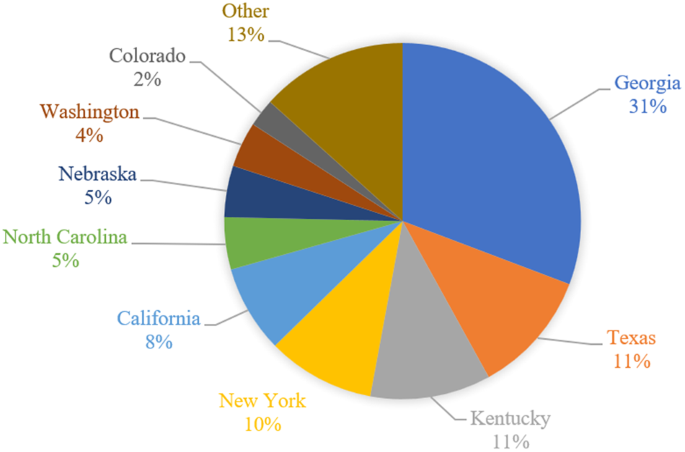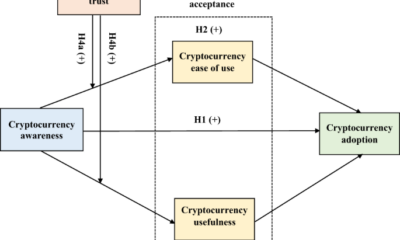News
La criptovaluta è uno strumento di copertura durante l’incertezza della politica economica? Un’indagine empirica

Recentemente, il fascino per le criptovalute è cresciuto e Bitcoin è emerso come il più notevole (Kristoufek & Lunackova, 2015). La criptovaluta, nel suo senso più ampio, si riferisce a una forma di valuta digitale che opera su Internet e indipendentemente da qualsiasi organo di governo centrale (Zohuri et al., 2022). Se le criptovalute possano fungere da mezzo di scambio è stato oggetto di alcune ricerche e i risultati sono stati contrastanti (Ammous, 2018). A causa del drammatico aumento del valore delle criptovalute nel 2017, gli investitori di tutto il mondo hanno iniziato a riversare gran parte del loro capitale di investimento in queste forme relativamente nuove di attività finanziarie. Tuttavia, non è stato possibile mantenere i prezzi gonfiati e il mercato delle criptovalute ha sperimentato lo scoppio della bolla dei prezzi prima della conclusione dell’anno. L’enorme volatilità del valore delle criptovalute dimostra il rischio connesso all’investimento in questo tipo di asset.
Le criptovalute vengono stabilite attraverso vari algoritmi crittografici e vengono scambiate in un regno digitale. Il continuo sviluppo di questo sistema, che mira a sostituire le valute esistenti, gli strumenti di pagamento e persino la teoria e le pratiche monetarie tradizionali, ne ha accresciuto nel tempo l’importanza (Alpago, 2018). Al contrario, tra studiosi ed esperti si discute se la criptovaluta sia un tipo di denaro o un asset volatile. Le opinioni divergono su questo fenomeno. I mercati finanziari globali hanno visto un rapido aumento della popolarità delle criptovalute (Białkowski, 2020; Deepa et al., 2022; Liu et al., 2021). Di conseguenza, i regolatori, i media e gli investitori individuali e istituzionali si sono tutti interessati a loro. Anche la ricerca accademica sulle criptovalute è diventata significativa (Almeida & Gonçalves, 2022). Una caratteristica sia dell’oro che del dollaro statunitense, il potenziale di copertura di Bitcoin è noto come mezzo di scambio o oro digitale (Su et al., 2023). Perché esiste un legame positivo tra i prezzi dell’oro e del Bitcoin, secondo (Selmi et al., 2022), l’oro e il Bitcoin hanno maggiori probabilità di integrarsi piuttosto che competere uno contro l’altro. Una posizione corta nel mercato Bitcoin consente di coprire il rischio quando si investe in vari altri asset finanziari Guesmi et al., (2019). In particolare, il rischio del portafoglio derivante dal detenere oro, petrolio e azioni è inferiore quando si detiene Bitcoin rispetto a quando non si detiene. Tuttavia, a causa delle restrizioni sulla legislazione antiriciclaggio e sul finanziamento del terrorismo, Bitcoin non può sostituire l’oro
I mercati delle criptovalute possono essere influenzati in vari modi prevedibili. Gli studi esistenti hanno esaminato il modo in cui i diversi parametri di incertezza influenzano la criptovaluta. Alcuni studi prevalenti su Bitcoin hanno esaminato l’impatto delle incertezze e dei rischi sui profitti delle criptovalute e sulla volatilità dei prezzi. Nella loro ricerca, Doumenis et al. (2021) discutono la correlazione tra l’indice di volatilità (VIX) e la volatilità delle criptovalute. I risultati della loro analisi rivelano che la volatilità del mercato delle criptovalute tende ad aumentare in risposta alla maggiore apprensione degli investitori. Nel loro studio, Fang et al. (2020) esaminano l’influenza dell’indice di volatilità implicita basato sulle notizie (NVIX) sulla volatilità delle criptovalute per un periodo prolungato. I ricercatori hanno scoperto che il NVIX ha un impatto negativo sulle fluttuazioni a lungo termine delle criptovalute. Nel loro studio (Gozgor, Tiwari, et al., 2019) esaminano la correlazione tra i rendimenti di Bitcoin e l’incertezza nelle politiche commerciali (TPU) negli Stati Uniti. I risultati della loro ricerca dimostrano un impatto negativo del TPU sui rendimenti di Bitcoin. In uno studio di Shaikh (2020), il ricercatore esamina l’impatto dell’indice di incertezza della politica economica (EPU) sui rendimenti del Bitcoin in molti paesi, tra cui Stati Uniti, Regno Unito, Giappone, Cina e Hong Kong. Lo studio rivela che l’incertezza ha avuto un effetto dannoso sul mercato Bitcoin negli Stati Uniti e in Giappone. Poiché il mondo moderno e finanziariamente connesso è più vulnerabile che mai ai rischi legati alla politica economica, i ricercatori si stanno attualmente concentrando sulla ricerca di un rifugio adeguato per proteggere le risorse.
Precedenti studi sono stati condotti sulla criptovaluta, principalmente su Bitcoin come entità singola con diverse misure legate all’incertezza. A nostra conoscenza, non sono stati condotti studi precedenti sulla criptovaluta in condizioni di incertezza sulla politica economica o sull’effetto asimmetrico dell’EPU sui rendimenti della criptovaluta. Gli obiettivi dello studio sono duplici: in primo luogo, comprendere meglio la letteratura accademica già disponibile sul comportamento degli investitori in criptovalute, raccogliere le sue conoscenze e identificare le lacune conoscitive per supportare studi futuri; e in secondo luogo, presentare risultati significativi della ricerca per investitori, accademici, politici, imprese, professionisti e società. Gli studi esistenti hanno tracciato la relazione tra criptovaluta e altri fattori diversi. A nostra conoscenza, questo studio è il primo ad analizzare il nesso tra criptovaluta e incertezza sulla politica economica dopo Covid-19. Selezioniamo le prime tre criptovalute in base alla loro quota di mercato: Bitcoin, Ethereum e Tether. Il periodo va dal 1° gennaio 2021 al 1° aprile 2023. Il periodo selezionato è successivo alla pandemia di COVID-19, che ha colpito ogni settore dell’economia mondiale. Pertanto riconosciamo l’importanza del tempo.
È interessante notare che nessuna pandemia o evento di incertezza più significativa, tra cui l’influenza spagnola, la crisi finanziaria globale e la crisi del debito europeo, ha mai peggiorato il mercato azionario e fatto scendere l’UEP tanto quanto il COVID-19. Poiché gli investitori sono prevalentemente preoccupati di perdere i propri investimenti, spesso definito come un riflesso di un comportamento avverso al rischio, la maggiore incertezza sulla politica economica spesso ostacola il flusso degli investimenti. Pertanto, durante le crisi finanziarie, i disordini politici o altri periodi di sostanziale incertezza, come la pandemia di COVID-19, gli investitori e i gestori di fondi sono attratti da strategie di riduzione del rischio. Al contrario, in Cina, osserviamo un effetto benefico dell’incertezza sul mercato dei Bitcoin (Chen et al., 2021). Il loro studio esamina la correlazione tra i rendimenti del Bitcoin e l’EPU cinese. I risultati della loro ricerca indicano un impatto favorevole dell’EPU cinese sui rendimenti del Bitcoin. Allo stesso modo, (Wu et al., 2021) esaminano l’effetto dell’EPU basata su Twitter sul mercato delle criptovalute. I loro risultati suggeriscono che l’EPU basata su Twitter ha un’influenza favorevole sui rendimenti delle criptovalute. Il Cryptocurrency Uncertainty Index (UCRY) è un nuovo proxy per misurare l’incertezza. UCRY è stato creato da (Karim et al., 2023) e si basa sull’esame del contenuto testuale.
Il significato dello studio
I mercati finanziari globali si trovano in una fase rivoluzionaria (Johnson, 2020) e la finanza digitale svolge un ruolo significativo nel modo in cui i servizi finanziari sono organizzati a livello mondiale (Johnson, 2020). Secondo (Hosen et al., 2022), la criptovaluta sta migliorando e moderando notevolmente i servizi finanziari tradizionali. Lo stato attuale dello sviluppo delle criptovalute è solitamente caratterizzato da comportamenti anomali e da eventi imprevisti che influenzano le opinioni delle persone, il comportamento del mercato e la legislazione pubblica (Treiblmaier, 2022). La trasmissione delle politiche fiscali e monetarie nei mercati finanziari è stata significativamente influenzata dall’incertezza, che ha acquisito maggiore importanza nelle economie moderne (Kang & Yoon, 2019). La regolamentazione della criptovaluta è necessaria poiché altera le transazioni finanziarie “tipiche” (Hossain, 2021); tuttavia, tenere il passo con la legislazione in molte giurisdizioni è impegnativo (Mohsin, 2022). Fin dalla loro nascita, le criptovalute sono state popolari nel settore finanziario (Jiménez-Serranía et al., 2021), e i mercati associati hanno una storia di volatilità (Chokor & Alfieri, 2021).
La letteratura precedente si è concentrata principalmente su questo argomento; poche pubblicazioni di ricerca hanno esaminato altre criptovalute. In linea con queste preoccupazioni, cerchiamo di riassumere la letteratura che si è concentrata sulle implicazioni economiche delle criptovalute. Per eseguire questa analisi, abbiamo cercato attentamente gli studi esistenti sulla criptovaluta nella letteratura accademica in espansione. Utilizziamo un approccio di regressione quantile per esaminare i dati. La metodologia di regressione quantilica è vantaggiosa perché ci aiuta a dare un senso ai risultati che non sono normalmente distribuiti e hanno relazioni non lineari con le variabili predittive consentendoci di comprendere le relazioni tra variabili al di fuori della media dei dati. Il nostro obiettivo è indagare sulle criptovalute con incertezza sulla politica economica globale. Pertanto, abbiamo scelto le prime tre criptovalute (Bitcoin, Ethereum e Tether) come variabile poiché sono criptovalute ben note. Per verificare la robustezza dei risultati, utilizziamo l’oro come copertura alternativa per la criptovaluta. Inoltre, in questo studio viene tracciata anche l’analisi dei singoli paesi. Gli Stati Uniti e la Cina sono noti per essere i due paesi chiave dell’economia mondiale e le loro quote di criptovaluta sono le più alte. Pertanto, selezioniamo questi due paesi ed eseguiamo la stessa analisi.
La crescente EPU globale ha un effetto dannoso sui rendimenti a lungo termine di Bitcoin. Il calo dell’EPU, d’altro canto, ha un impatto favorevole, dimostrando che una volta che le preoccupazioni si sono attenuate, gli investitori recuperano la fiducia nel mercato dei Bitcoin. Probabilmente, questi investimenti non fungono da rifugio sicuro a lungo termine. Tether beneficia dell’aumento dell’EPU grazie al suo status valutario stabile e alla sua posizione a lungo termine come bene rifugio. Si prevede che asset rifugio come Bitcoin, Ethereum e Tether trarranno beneficio nel breve termine e mostreranno potenziale.
Motivazione dello studio
Nel 2020 è stata esercitata una significativa pressione al ribasso sulla crescita economica a causa delle misure di contenimento della pandemia adottate dalle autorità a tutti i livelli. Queste misure includono l’isolamento domestico, il distanziamento sociale, le restrizioni ai viaggi e ai trasporti e la sospensione temporanea delle attività economiche non essenziali. Queste misure di riduzione del COVID-19 hanno rappresentato uno shock tremendo per le reti di capitale delle microimprese, rendendo difficile il mantenimento delle operazioni generali; secondo un sondaggio condotto nel febbraio 2020, il 72,87% delle imprese Internet e il 68,39% delle imprese che operavano principalmente offline prevedevano di essere in grado di mantenere i propri flussi di cassa per non più di tre mesi. La criptovaluta è in una posizione unica come pioniere in una tecnologia che potrebbe alterare radicalmente le istituzioni finanziarie convenzionali (Marella et al., 2020). Esiste ancora disaccordo sul fatto che le criptovalute svolgano le tre funzioni di mezzo di scambio monetario, unità di conto e riserva di valore, nonostante la crescita esponenziale del numero di aziende che accettano pagamenti Bitcoin (Harb et al., 2022). I ruoli delle criptovalute stabili e instabili influiscono sulle dinamiche del mercato Bitcoin (Qiao et al., 2023). Diversi studi sull’economia delle criptovalute (Almeida & Gonçalves, 2023) hanno tentato di determinare perché i mercati delle criptovalute attraversano delle bolle. Ad esempio (Karim et al., 2023) sottolineano che fattori quali volatilità, volume degli scambi, volume delle transazioni, VIX e ricerche su Google non possono prevedere i rendimenti dei bitcoin. Mentre (Huang et al., 2019) suggeriscono che gli indicatori ad alta dimensione possono prevedere i rendimenti del bitcoin, (Balcilar et al., 2023) dimostrano che il volume può prevedere i rendimenti utilizzando modelli non lineari. Pertanto, in questo studio, analizziamo il nesso tra l’incertezza della politica economica e i rendimenti delle criptovalute.
I risultati del nesso EPU-bitcoin specifico per paese dimostrano che l’EPU degli Stati Uniti, che domina l’economia globale, ha un’influenza persistentemente negativa sui rendimenti del bitcoin. Tuttavia, l’EPU cinese ha un impatto minimo o nullo a lungo termine su Bitcoin. A causa del loro ruolo significativo nell’economia globale, gli Stati Uniti sono vulnerabili a questi e ad altri effetti globali (Chowdhury & Abdullah, 2023). L’EPU ha avuto un impatto favorevole e significativo sui rendimenti delle criptovalute, ad eccezione dei prezzi del petrolio. Figure 1 E 2 nell’appendice rappresentano gli hash rate statali e provinciali rispettivamente in Cina e negli Stati Uniti. La Georgia ha il tasso più alto, seguita da Texas e Kentucky. Successivamente, New York e la California hanno registrato le quote maggiori. Per quanto riguarda la Cina, lo Xinjiang ha la quota più alta con una quota del 50%, seguito da Sichuan e Yunnan con rispettivamente il 21% e il 7%.
News
US Cryptocurrency Rules Delayed by ‘Never-Ending’ Lawsuits

Ripple CEO says cryptocurrency industry still seeking regulatory clarity from US
Speaking to Bloomberg News on Wednesday (July 17), Author: Brad Garlinghouse he said America is behind behind other countries which have already adopted cryptocurrency regulations.
“What we’re seeing, where it’s the UK, Japan, Singapore… even the European Union, more than two dozen countries have come together to provide a framework for cryptocurrency regulation,” Garlinghouse said.
“It’s frustrating that we as a country can’t get that regulatory framework in place. And instead, we have this never-ending lawsuit coming from the SEC that doesn’t really address the problem.”
Ripple has been the target of some of these legal disputes. Securities and Exchange Commission (SEC) sued the company in 2020, accusing it of conducting a $1.3 billion operation offering of unregistered securities tied to its XRP token.
However, last year a judge ruled that only Ripple’s institutional sales of XRP, not retail sales, violated the law, a decision widely seen as a victory for the cryptocurrency industry.
As PYMNTS noted at the time, that ruling has “far-reaching repercussions impact across the digital asset ecosystem, which has long maintained that its tokens do not represent securities contracts.”
However, Garlinghouse told Bloomberg on Wednesday that the company cannot wage multimillion-dollar legal battles over each token.
He spoke to the news agency from the Republican National Convention in Milwaukee, where the party is backing the candidacies of former President Donald Trump and Ohio Sen. J.D. Vance, both of whom are considered pro-cryptocurrency.
But Garlinghouse argued that cryptocurrencies “should not be a partisan issue,” and noted that he had recently attended a conference in Washington that included Democrats, including White House officials.
“I think they were there, listening to the industry… it was refreshing to start having that conversation,” she said.
President Joe Biden earlier this year he vetoed a measure which would have ended the SEC’s special rules for crypto-asset custodians. This legislation was supported by both the digital asset industry and the banking industry.
Ripple early this year donated $25 million to the cryptocurrency industry’s super PAC Fair Smoothiewith Garlinghouse stating at the time that such donations would continue every year, as long as the industry had its detractors.
Second Open SecretsWhich monitor spending For campaigns, the PAC has spent $13.4 million this year, much of it to help defeat Rep. Katie Porter’s (D-Calif.) U.S. Senate campaign.
News
The Future of Cybersecurity in the Cryptocurrency Industry

The cryptocurrency space has had a tumultuous journey, with its fair share of ups and downs. As we look to the future, one area that remains a constant focus is cybersecurity. The digital nature of cryptocurrencies makes them inherently vulnerable to cyber threats, and as the industry evolves, so does the landscape of potential risks.
In 2022, the cryptocurrency market faced significant challenges, with over $2 trillion in market value lost. This event served as a wake-up call for the industry, highlighting the need for robust cybersecurity measures. The future of cryptocurrency security is expected to see a shift towards more regulated and established institutions taking the reins of crypto technology and blockchain infrastructure.
The decentralized nature of cryptocurrencies offers numerous benefits, such as transparency and financial inclusion. However, it also introduces unique security challenges. The risk landscape is filled with threats such as hacking, phishing, ransomware attacks, malware, and social engineering. These threats not only lead to financial losses, but also damage the reputation and trust within the cryptocurrency ecosystem.
Mini-MBA Tekedia edition 15 ((September 9 – December 7, 2024) started recordings; Register today for discounts reserved for early bird customers.
Tekedia AI in Business Masterclass Opens registrations Here.
Join the Tekedia Capital Syndicate and IInvest in Africa’s best startups Here.
The decentralized nature of cryptocurrencies offers many benefits, but it also presents unique security challenges. Cyber risks such as hacking, phishing, and ransomware pose threats to the integrity of digital assets. The infrastructure that supports cryptocurrencies is not immune to vulnerabilities, including smart contract flaws and exchange hacks.
To address these vulnerabilities, the infrastructure that supports cryptocurrencies must be strengthened. Smart contract vulnerabilities, exchange hacks, wallet breaches, and flaws in the underlying blockchain technology are significant concerns that must be addressed to ensure the security and integrity of digital assets.
As cybercriminal tactics and techniques become more sophisticated, the cryptocurrency industry must stay ahead of the curve. The future will likely see more targeted attacks, exploiting weaknesses in infrastructure, networks, and human factors. This requires a proactive and multifaceted approach to cybersecurity.
To mitigate these risks, several measures must be adopted:
Strengthening security measures: Developers, exchanges, and wallet providers must improve security protocols, use strong encryption, implement multi-factor authentication, and conduct regular security audits.
Education and awareness: Users should be educated on best practices for protecting their digital assets, including using strong passwords, recognizing phishing attempts, and using hardware wallets for secure storage.
Looking ahead, the cryptocurrency industry is expected to see an increased focus on robust security measures. Blockchain projects and exchanges are likely to invest in advanced encryption techniques and decentralized storage solutions to protect user assets. The future impact of cyber risk on cryptocurrencies will depend on the collective efforts of stakeholders to address vulnerabilities and strengthen security measures.
Collective efforts by stakeholders in the cryptocurrency space are crucial to address vulnerabilities and strengthen security measures. While challenges persist, advances in cybersecurity technologies and practices offer hope for a more secure and resilient cryptocurrency ecosystem.
The future of cybersecurity in the cryptocurrency industry depends on finding a balance between innovation and regulation. It requires a collaborative effort from all parties involved, from developers to end users, to create a secure environment that fosters trust and growth in the industry. As we move forward, it is critical that lessons learned from past events guide the development of stronger security measures, ensuring the longevity and stability of cryptocurrencies as a vital part of the modern economic toolkit.
Like this:
Like Loading…
News
Bullish XRP and RLBK price predictions rise, outpacing the broader cryptocurrency market, prompting Shiba Inu holders to switch!

Bitcoin’s one-week surge from $60,000 has pushed other cryptocurrencies into an uptrend. However, for many altcoins, this trend has been temporary. Altcoins such as XRP and Shiba Inu (SHIB) have experienced price drops. However, Rollblock, a new altcoin on the Ethereum blockchain, has thrived during this period, attracting thousands of investors looking for long-term growth.
XRP’s Nearly 30% Growth Over Last Week Drops as Selling Pressure Increases
XRP is seeing further price decline as Ripple investors withdraw their profits from the token. The surge in XRP’s price to $0.64 in the past week has provided investors with a perfect opportunity to increase their returns in the short term. With the ongoing sell-off in XRP, XRP has jumped over 8% in the past day and is now trading at $0.59. However, analysts tracking XRP indicators predict that XRP could still extend its gains by over 30% in the coming weeks.
Shiba Inu (SHIB) marks its third consecutive day of losses
Shiba Inu (SHIB) is in a period of adjustment after a week of strong gains. In the last 24 hours, SHIB has seen a jump of over 7%, reflecting a natural market fluctuation. Analysts are observing a death cross on the Shiba Inu chart, which historically signals the potential for future opportunities as the market stabilizes. As investors explore new possibilities, some are diversifying into promising altcoins like Rollblock (RBLK) to strategically rebalance their portfolios and capitalize on the emerging trend.
Rollblock (RBLK) Up Another 7% as New Investors Join Pre-Sale
Rollblock (RBLK) has taken the cryptocurrency market by storm, having attracted investors from more popular altcoins like Shiba Inu (SHIB) and XRP. Rollblock’s growth is attributed to its utility in the $450 billion global gaming industry.
Rollblock aims to use blockchain technology to bridge the gap between centralized and decentralized gambling. With blockchain technology, Rollblock secures every transaction in its online casino, providing transparency and convenience to millions of players who are uncomfortable placing bets on other iGaming platforms.
This innovative use of blockchain technology in the industry has grown Rollblock to over 4,000 new users in less than two months. With plans to add sports betting, this number is expected to grow exponentially in Q3.
Rollblock uses a revenue sharing model that splits up to 30% of its casino’s weekly profits with token holders. This happens after Rollblock buys back $RBLK from the open market and uses half of it for rewards. The other half is burned to increase the price of $RBLK.
Rollblock price has seen four increases in the past month with $RBLK tokens now selling for $0.017. Analysts predict that at the current growth rate, Rollblock could increase by over 800% before the presale ends. For investors looking for a long-term token with growth potential, phase four is the best time to buy Rollblock before its price skyrockets!
Discover the exciting Rollblock (RBLK) pre-sale opportunities now!
Website:https://Rollblockpresale.io/
Social: https://linktr.ee/Rollblockcasino
No spam, no lies, just insights. You can unsubscribe at any time.
News
Texas Crypto Miners Turn to AI as Crypto Declines

As cryptocurrency mining becomes less profitable, Texas cryptocurrency mining companies are switching to supporting artificial intelligence companies.
Bitcoin miners, with their sprawling data centers and access to significant energy resources, are ideally suited for computationally intensive AI operations, and as cryptocurrency mining becomes less profitable, companies see this shift as a logical answer to their problems.
On Thursday, Houston-based Lancium and Denver-based Crusoe Energy Systems announced a multibillion-dollar deal to build a 200-megawatt data center near the West Texas city of Abilene to support advanced artificial intelligence applications such as medical research and aircraft design, CNBC reported. The plant represents the first phase of a larger 1.2 gigawatt project.
Lancium and Crusoe’s move into AI mirrors a broader trend among bitcoin miners. The combined market capitalization of the top U.S.-listed bitcoin miners hit a record $22.8 billion in June. Companies like Bit Digital and Hut 8 are diversifying into AI, with Bit Digital securing a $92 million annual revenue deal to supply Nvidia GPUs and Hut 8 raising $150 million to expand its AI data center.
But the growing popularity of these operations also presents challenges, particularly for the Texas power grid. Last month, the Electric Reliability Council of Texas announced that the state is expected to nearly double its energy production by 2030 to meet the high energy demands of data centers and cryptocurrency operations.
Lieutenant Governor Dan Patrick expressed concern about the projections.
“Cryptocurrency miners and data centers will account for more than 50% of the additional growth. We need to take a close look at these two sectors,” He wrote on Twitter/X. “They produce very few jobs compared to the incredible demands they place on our network. Cryptocurrency miners could actually make more money selling electricity to the network than they do from their cryptocurrency mining operations.”
Analysts predict significant growth in data center power capacity, which is expected to account for up to 9% of U.S. electricity consumption by 2030.
The operations also pose challenges for nearby cities. Earlier this month, TIME reported that a crypto-mining facility was seriously compromising the health of residents in the city of Granbury. TIME reported more than 40 people with serious health problems, including cardiovascular disease, high blood pressure and hearing loss. At least 10 of the residents needed to go to the emergency room or an urgent care facility.
The disturbances were caused by the extreme noise generated by the crypto-mining facility’s fans, which are used to keep the machines cool. While the proposed data center in Abilene would use liquid cooling systems, it’s still unclear whether the facility’s operations would pose a health risk to local residents.
-

 Nfts1 year ago
Nfts1 year agoShardLab Launches ZK-Based Tool for Digital Identity and NFT Vouchers
-

 News1 year ago
News1 year agoWallet recovery firms are abuzz as stranded cryptocurrency investors panic in the bitcoin boom
-

 Bitcoin12 months ago
Bitcoin12 months agoBitcoin, Ethereum, Solana and Cryptocurrency Markets Look Ready to ‘Send’ as Stars Align, According to Investor Chris Burniske
-

 Altcoins12 months ago
Altcoins12 months agoThree Altcoins Poised for Significant Growth in 2024: ETFS, OP, BLAST
-

 Altcoins12 months ago
Altcoins12 months agoAccumulate these altcoins now for maximum gains
-

 Nfts12 months ago
Nfts12 months agoOG Crypto Artist Trevor Jones Unveils Groundbreaking Collection of Ordinals | NFT CULTURE | NFT News | Web3 Culture
-

 Bitcoin12 months ago
Bitcoin12 months agoBillionaires are selling Nvidia stock and buying an index fund that could rise as much as 5,655%, according to some Wall Street analysts
-

 Videos8 months ago
Videos8 months agoKamala just won the boner! [Bad For Crypto]
-

 Videos1 year ago
Videos1 year agoLIVE FOMC 🚨 Could be CATASTROPHIC for Altcoins!
-

 News1 year ago
News1 year agoA Guide for Newcomers & Beginners – Forbes Advisor
-

 Videos1 year ago
Videos1 year agoAttention: a historically significant BITCOIN signal has just appeared!
-

 Videos1 year ago
Videos1 year agoSTOCK MARKET FUD! ⚠️ [Why This Is GREAT For Bitcoin Traders!]









